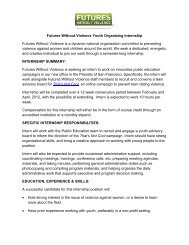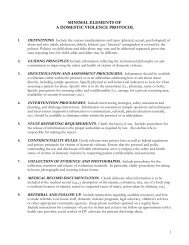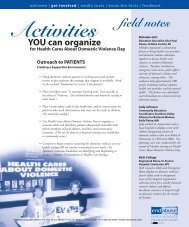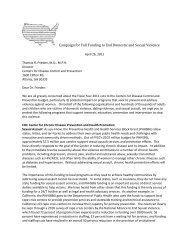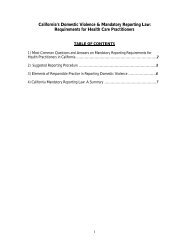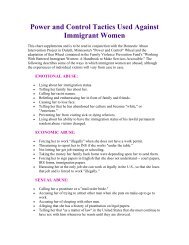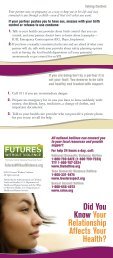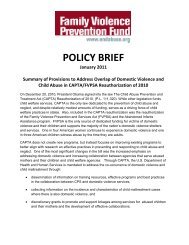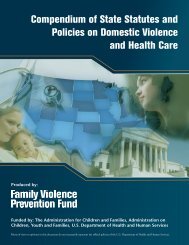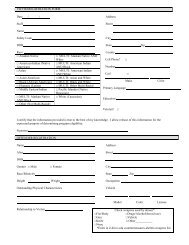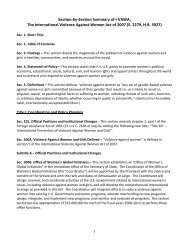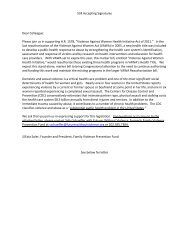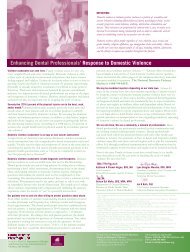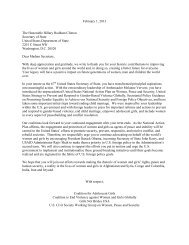Team Decisionmaking and Domestic Violence: Guidelines for ...
Team Decisionmaking and Domestic Violence: Guidelines for ...
Team Decisionmaking and Domestic Violence: Guidelines for ...
Create successful ePaper yourself
Turn your PDF publications into a flip-book with our unique Google optimized e-Paper software.
Better Safety St<strong>and</strong>ards<br />
Higher st<strong>and</strong>ards <strong>for</strong> TDM meetings should be possible when facilitators <strong>and</strong> child protection<br />
staff consistently employ best practice strategies in DV situations.<br />
1. TDM meetings should not increase risk (potential <strong>for</strong> future harm) to a child<br />
or the non-offending parent. Doing so may result<br />
in the child remaining in care longer than is necessary.<br />
Actions that might increase risk include:<br />
• Discussing DV in the TDM meeting without<br />
having talked to each parent separately.<br />
• Asking the child <strong>and</strong> mother to disclose DV in a<br />
meeting.<br />
• Confronting a father who uses violence without<br />
care <strong>and</strong> consideration <strong>for</strong> the safety of the mother<br />
<strong>and</strong> child.<br />
• Sharing in<strong>for</strong>mation with the father about what<br />
the mother has said without her permission.<br />
2. TDM participants should hold a perpetrator of violence accountable <strong>for</strong> his<br />
behavior to increase safety <strong>and</strong> decrease risk to the child. Holding him accountable<br />
can include:<br />
• Referring him to a certified batterer intervention program.<br />
• Having direct, respectful conversations with him about his behavior.<br />
• Communicating with his probation or parole officer to report concerns <strong>and</strong> to coordinate<br />
planning.<br />
• Enlisting others with whom he has a relationship<br />
(e.g., a pastor, a brother, his<br />
mother, etc.) to talk to him about changing<br />
his behavior.<br />
• Communicating with his other providers<br />
(a therapist, a substance abuse program,<br />
etc.) about his violence.<br />
• Basing his contact with his child (visitation,<br />
reunification) on his changing his<br />
behavior.<br />
NOTE<br />
This is not an exhaustive list,<br />
but instead some examples of<br />
actions that might increase risk<br />
to both the child <strong>and</strong> the mother<br />
in a TDM meeting. TDM workers<br />
should always use their best<br />
judgment in a meeting situation<br />
to decrease risk.<br />
CAUTION<br />
Ef<strong>for</strong>ts to hold a perpetrator of violence<br />
accountable <strong>for</strong> his behavior can increase<br />
danger or risk to a child <strong>and</strong> her/his mother.<br />
The non-offending parent should be<br />
consulted both prior to attempting these<br />
strategies <strong>and</strong> after such attempts to assess<br />
how the perpetrator has responded.<br />
<strong>Team</strong> <strong>Decisionmaking</strong> <strong>and</strong> <strong>Domestic</strong> <strong>Violence</strong>: <strong>Guidelines</strong> <strong>for</strong> Facilitators 9




